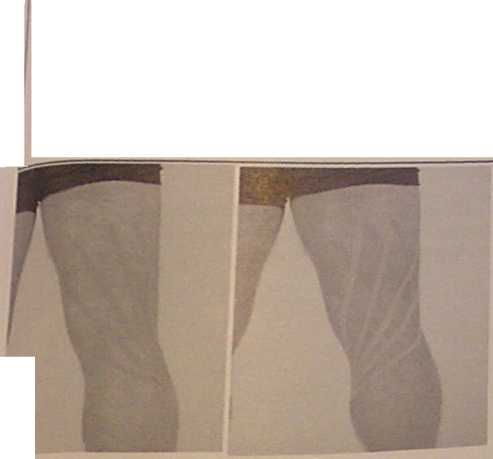P5140098
the
The sccond strip should be posterior medial aspect of the CnłfC<?d from anterior aspect of the femoral COr^
to U,
The tHird strip should be placed fw, tifc>«al plateau directly below the insert!^ the
to the superior aspect of the femoral conrf. ‘eMęr pattem should be repeated at least twiCe p This larger athlete the pattem should be repeated £l times. t^nee

l Jnon completion of support strips the comPiei nolication needs to be covered to minimize aPe aPP and unraveling ci u ring activity. A light nigTatl° should be selected (Lightplast, Sheer-ylastic tape should be given to not apply tape
ight) and c . tension, as to limit drculation and Arith to muert white nonelastic tape is used to
strips to limit constriction of
IoVer, use oruy ,
issue- the elastic tape brom the calf re,
Begin to assist in lim-ting the
the knee- e to ^g|
e a0plying 4116 ^
o >f a
|astic tape num tt«= ta*‘ region ssist in li miting the possibility tightly limiting drculation
A hyperextension injury to the knee is a common injury resulting from the knee being forccd past 0 jegrees of extension (for females normal extension position may be up to +3 degrees). Gencrally the knee has marked edema with pain occurring In knee extension.
The Kineslo technique will include a Iymphatic corrective taping to reduce acute edema, basie fumstring muscle taping, and functional correction to limit knee cxtension during the acute phase.


Knee Hyperextension
Application of the Iymphatic corrective technique to the popliteal fossa. For complete review see Iymphatic correction application. TWo strips will be applied.
Photo on left: Strip one, begin inferior to the media 1 condyle of the femur, cross over the popliteal space, ending above the region of swelling.
Photo on right: Second strip, begin inferior to the lateral condyle of the femur, cross over the popliteal space, ending above the region of swelling.
The two Iymphatic corrective strips should form a crisscross pattem over the popliteal space.
Application of the functional corrective technique to limit knee extension. For complete review see functional correction technique.
The degree of knee extension to limit is determined by the practitioner during evaluation. The desired result would be limitation of knee extension just short of a painful position by the patient.
Place the base of the functional correction approxi-mately 4 inches above and below the knee, morę than one strip may be reąuired. Make surę to hołd the two bases when the patient moves into knee exten-sion.
Application of the hamstring muscle basie Kinesio taping technique. The desired result will be de-creased muscle spasm in the hamstring muscle from over extension during forced knee hyperextension. The hamstring should be taped using the insertion to origin method.
Method demonstrated has the hamstring taped prior to the functional correction.
151
Wyszukiwarka
Podobne podstrony:
(12) Provision should be madę for research into the paediatric use of medicinal products which
Logistyka - nauka means that they should be accessible for vessels of 1500 deadweight, they should h
Giraff (2) Ho Kes Safari Kit Thcse padem details should be used in conjunclion wil
House (12) Po^m-^A-J-Pes HouseWillow Pattern Kit These pattern details should be used in conjunction
dpp09 MY EARLY BAYS S stated in the introduction to this book, I should be untruth- ful did I follow
Christmas kit 7 Santa l-orm-jA-Lines SantaChristmas Kit 7 Thcvc paltern dctails should be used in cn
Christmas tree instructions mesPo rm-y-P Christmas TreeChristmas Kit 3 These pattem details should b
Cats on wall Cat Kit Cats on a wali These pattem details should be used in conjunction willi the Fon
Cat Window Kit Horm-yK-LinesCat Window Kit These pattern details should be used in
Zirgai (7) Horse KitShow Jumping lhesc patiem dciails should be uscd in coisjunction with the Fom-A-
DSC07434 1 the one regarding revitalization of villages. Thus, there should be put a question: which
Lion (6) lro^m-;A-.Lmes Safari Kit Thcse paltem details should be uscd in conjunclion wiih the Form
57a 2 mes Water WheelCountry Scenes These pattern details should be used in conjunction with the For
58a Ir o Pm-jA-Li rvesFlowers in a vaseFolk Art Flowers These pattern details should be used in conj
więcej podobnych podstron